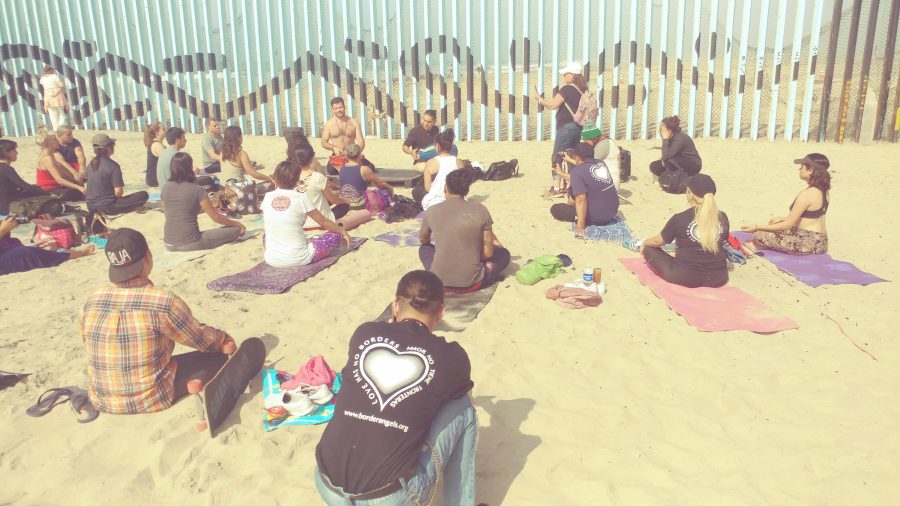An on-campus teach-in explains the recent San Diego border closure and aims to educate students about immigration.
Following Oct. 13, a caravan of Central American migrants traveling to the United States has become a point of fixation for President Donald Trump, who temporarily closed a few San Diego border crossings in late November to presumably prevent the caravan’s entry into the United States. Since then, another caravan has formed in Honduras, and the U.S. government is experiencing a temporary shutdown because Trump has been unable to obtain funding for his proposed U.S.-Mexico border wall.
The Center for U.S.-Mexican Studies hosted a Migrant Caravan Teach-In on Thursday, Nov. 29 to educate the UC San Diego community about the caravan and the topics of immigration, law, and ethics at large. The event consisted of a series of 10-minute lectures from six different speakers and included a Q&A segment.
A Roger Revelle College junior Alexandra Alvarenga, who helped organize the event as chair of the Movimiento Estudiantil Chicano de Aztlán, reminded audience members to acknowledge their privilege, especially in regards to their attendance at such an event.
“It’s important to be aware of your own privilege,” she said. “We’re talking about asylum-seekers in a space where they can’t even be. It’s important to always keep that in the back of your mind as you’re doing things in your everyday life, because that in itself goes a long way, just to have that kind of awareness and that kind of knowledge.”
The teach-in broadly outlined the must-know information about this caravan and also delved deeper into niche topics typically glossed over by mainstream media coverage, such as the violence faced by the LGBTQ migrant community and the caravan’s difficulty in accessing medical services. The speakers explained that this particular migrant caravan consists of people mostly from the Central American countries of Honduras, Guatemala, and El Salvador who are fleeing issues such as violence and government corruption. The caravan is traveling toward the United States for multiple reasons, including greater economic opportunity and the chance to reunite with family members already here. Group travel in a caravan provides increased visibility and security to the group, especially in Mexico, where migrants are frequently held hostage, assaulted, and killed by gangs and police.
In response to the migrant caravan, Trump issued a 90-day Presidential Proclamation Addressing Mass Migration Through the Southern Border of the United States on Nov. 9. It stipulates that anyone illegally entering the U.S. outside of ports of entry will not be eligible for asylum. By prohibiting entrance outside of the ports of entry, Trump aims to channel migrants to the specific ports of entry themselves. This, in turn, makes it easier to curb immigration and process migrants according to the administration’s preference. Many have started colloquially referring to this decision as the “asylum ban.”
“Despite all the politics around this, all the racism, xenophobia,” political science professor Tom Wong said during his presentation, “[the Trump Administration] know[s] how to play the law, and that’s why ‘asylum ban’ is in quotation marks. They’re trying to do the ‘asylum ban’ in the same way they did the travel/Muslim ban.”
However, as Wong proceeded to point out in his presentation, the proclamation violates the Immigration and Nationality Act, which states that any individual can claim asylum irrespective of where they enter the United States. Trump is thus attempting to change by presidential proclamation asylum rules lawfully implemented by Congress.
“Say it with me,” Wong said to the audience after explaining how INA lawfully protects asylum. “Asylum is a right.”
Read more:
The Story Behind the UC San Diego Pep Band and How They Learned to March to the Beat of Their Own Drum
“Whitelash:” Student Theater Delves into Politics and the Value of Unity
Freed, Dreamer Yakobi is a Changed Man
On Nov. 19, a federal judge issued a temporary restraining order on the interim rule implementing Trump’s Nov. 9 proclamation. This restraining order, effective until Dec. 19, 2019, prevents Trump from changing asylum law via presidential proclamation. However, as Wong pointed out, it also allows the administration more time to decide how to proceed within the confines of the law.
It is one thing to understand the legal implications of what’s happening at the border, but another to understand its immediate, and more often directly identifiable, social impacts. Sixth College senior Xiangdi Zhang was in Tijuana with her friend Shannell Ciruso when Trump closed the border. The student organization Movement Exchange at UCSD was at Yoga by the Border, a monthly event in which people come together from both sides of the border for binational yoga and meditation. Zhang recalls being alerted by a San Diego Union-Tribune reporter that the border was in the process of being shut down and then hurriedly driving to different crossing points with her group only to find them already closed.
“We drove to San Ysidro first,” she said. “It was closed; nobody could go through. We tried to drive to Otay Mesa — closed — and then to Tecate. … We drove, I think halfway, to Mexicali and turned around. It was just a lot of driving around, not knowing where to go, very disoriented. … There was an app designed to indicate border wait time, a border crossing app, but turns out it wasn’t very accurate because so many people queued up. I also have videos of how long the line was [in] Otay [Mesa] — we were just driving, and the line, it was maybe like from [RIMAC] all the way down to Revelle — that’s how long it was. And that’s for one crosspoint. It’s supposed to be easily done.”
She personally saw the caravan when it was close to the border.
“I saw [the people in the caravan] were living in tents close to the border,” she said, describing her glimpse of the migrant caravan. “We saw the narrow street filled with people — it was just not ending. That wasn’t even all of them. There were more in the stadium. A lot of people say a picture is worth a thousand words, but actually seeing it is different. … To this day, I’m still processing what’s happening, you know what I mean? On the other side, they’re people just like you and me. And is it wrong for them to try to seek a better life? No, it’s not. So is it wrong for the government to try to regulate? I can’t say it’s wrong, but it’s not doing it in the right way.”
Zhang, an international student from China, brings a unique perspective to the topic of immigration and views it as a broader international issue as opposed to a bipartisan Democratic or Republican one. Her experience at the border did not scare her because she had experienced something similar before. When she was traveling as a 14 year old, her flight had a layover in Egypt, coincidentally right as the Arab Spring began. The airport shut down, and she was in the airport for a week without food until the Chinese government sent a refugee airplane.
“I knew the Chinese government was working on it — my country was going to come for me anyways,” she said, drawing a comparison between her experience and the current situation at the border. “There was a certain level of reassurance that I was going to get home and that there was a place called home. … Most people [were] hosted at the stadium, but it was so overpopulated that most people were on the streets, in tents. I couldn’t help but think how people — let’s say kids in that situation — don’t have food, are in poor sanitation. The biggest difference between my 14-year-old self and them is not knowing where home is. Most of them can’t go home because of violence — especially women experiencing gendered violence.”
In addition to the difficult conditions migrants face and go through, they are often poorly received by local people, especially in Mexico.
“There’s the fact that Mexican people didn’t like them there — I was actually talking to the Uber driver there, and I asked him about it. He was like, ‘We don’t like them here. We don’t want them. They’re dirtying up the city.’ And I couldn’t help but think how this is the same narrative: Americans don’t want Mexicans and then Mexicans don’t want Hondurans, or wherever anyone in the caravan [is] from. They can’t go home, and they’re certainly not welcome in the U.S. … so I’m wondering, what’s the future for them?”
Despite UCSD being so close to the border, it remains an overly idealistic bubble isolated from many of the world’s greater problems. Zhang, however, hopes UCSD students become more aware of their proximity to some of the world’s most impactful current events, and she encourages them to volunteer or get involved at the border. Students can participate in desert water drops along migrant crossing routes by volunteering with the nonprofit organization Border Angels, or participate in Yoga by the Border, as Zhang did herself.
“When you hear about it on the news, you don’t think it’s real — you think it’s far away,” Zhang said. “Experiencing it would make you feel more connected to the community. We are so close to the border. It’s only 25 minutes away. It’s so bizarre to think about us sitting here, talking about it, and there are people, another kid, similar to our age.”
She trailed off and then paused for a moment. “It’s bizarre to think how such different lives could happen at the same time.”
Photos and video provided by Xiangdi Zhang.







